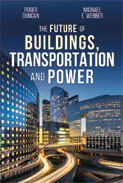
 |
As the title aptly indicates, this volume explores the possibilities and probabilities of future technologies in building, transportation, and power infrastructure. The topics focus upon the increasing exchange of power and information among these systems and the energy requirements necessary to manufacture and sustain these networks. Authors Duncan and Webber are well equipped to lead this discussion as academics engaged in university research and education concerning energy resources, energy efficiency, energy policy, and environmental sustainability. They are also involved outside academia in various activities related to energy and the environment.
The book is organized into five parts containing ten chapters. Part 1 eases readers into the authors' vision of energy efficiency, delineating how the three sectors of building, transportation, and power will converge in the future and will likely function with "less material, less motion, and in less time." Well noted is the primary problem of energy conversion that results in pollution, waste heat, and wasted motion: "The abundance of waste is the starting point for improving the global energy system, and is one of our motivations for writing this book."
Part 2 investigates the future of building trends, sustainable construction, and sentient-appearing, "smart" buildings. "As creepy as it may sound, in the future we will be living, working, and moving about inside robots." Part 3 discusses the future of transportation, the energy requirements involved, and sentient-appearing transportation. Both practical forms of transportation by conventional vehicles and the impractical and ethereal forms such as energetic teleportation are covered. Part 4 discusses the critical subject of our evolving power industry, clean energy solutions, and the nature of advanced power systems. "If the story of humanity is a long history of harnessing energy and moving from one fuel source to another, the subtext is an inexorable shift from high-carbon fuels to ever lower ones." Part 5 concludes with the authors' speculation on future technologies and whether these are attainable and sustainable. "Nanotechnology will continue to be the driver in material technology, creating new materials… while improving quality and reducing manufacturing waste."
Relevant historical material throughout each section offers deeper insight into the previous and current evolution of technology in the building, transportation, and energy sectors. Highlighted are some key historical thinkers and inventors who have contributed to these fields, such as Thomas Edison, Nikola Tesla, and Buckminster Fuller, and some influential contemporary figures, such as Richard Branson, Jeff Bezos, Elon Musk, Ray Kurzweil, and others who currently advance building, transportation, and energy trends.
The narrative's beauty is not only in the condensed but highly informative overviews of each topic but in the accessible prose, making what could be a dry, technical discussion accessible, lively, and interesting to lay readers. The summaries at each chapter ending help to focus upon and clarify the chapter topics, while the entertaining prologues at the beginning of Parts 2-5 provide a human experiential element that aptly illustrates how future trends in "smart" building technology and transportation may affect our daily lives. The book's information is well-cited, and, in addition to extensive endnotes, a nicely organized index makes the book handy for classroom use and student research. As the book went to press, the coronavirus pandemic emerged, so the authors added a relevant note and some pertinent updates to address that potential influence. Ultimately, despite many pressing issues and obstacles, Duncan and Webber are positive about the future of energy: "There is no doubt that we can achieve sustainable, emissions-free operations of our buildings, transportation, and power. This book has shown the many ways we are moving toward that sustainable future."
RECOMMENDED by the US Review
Next Focus Review
Previous Focus Review